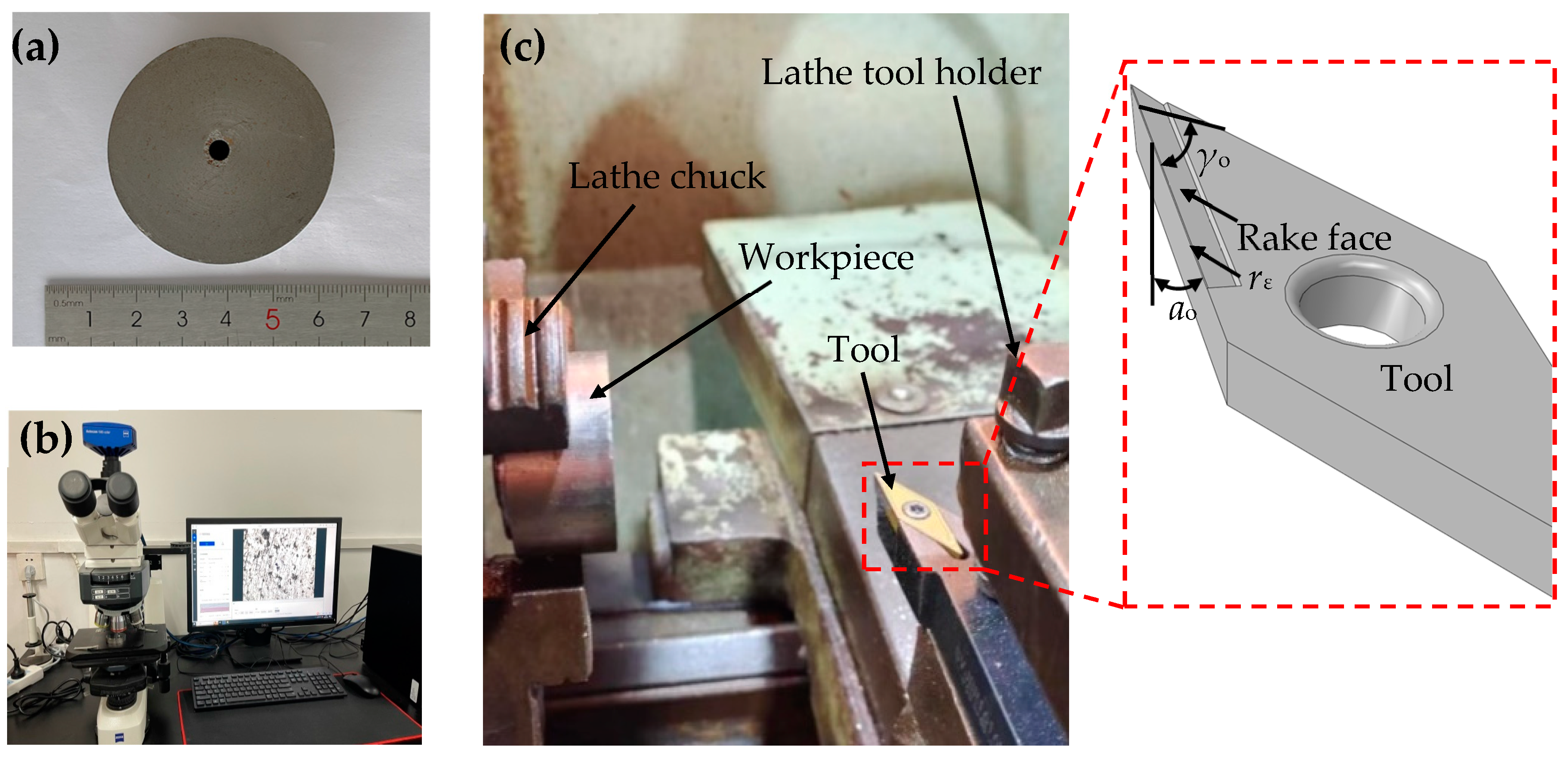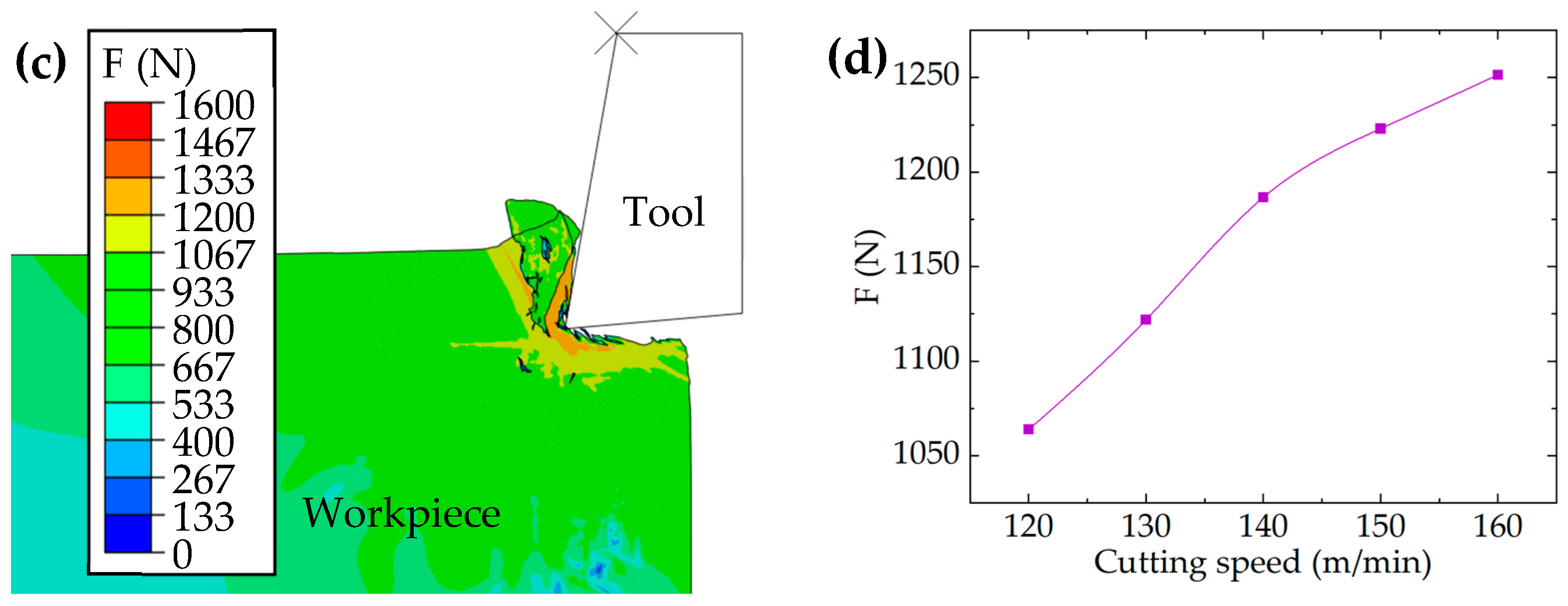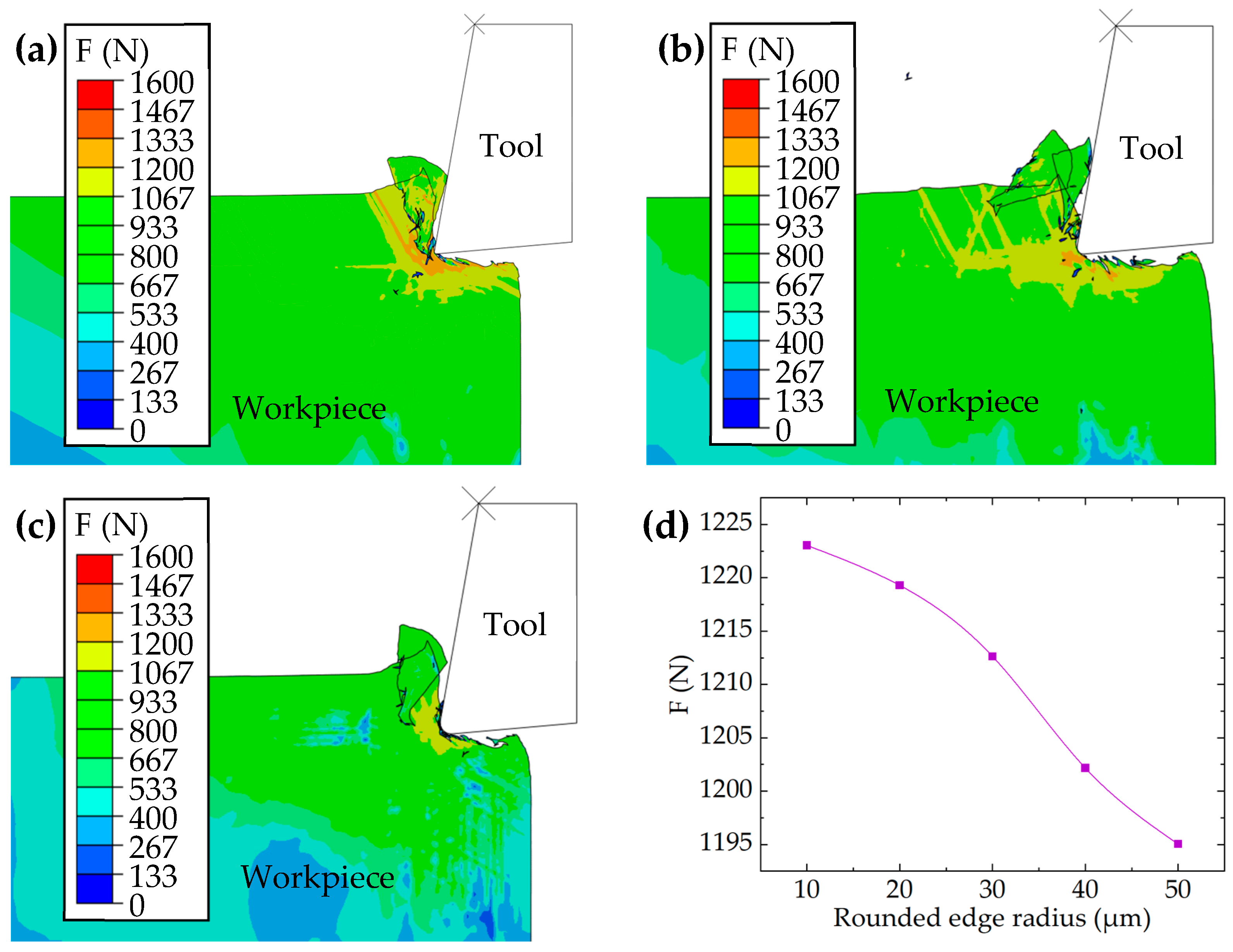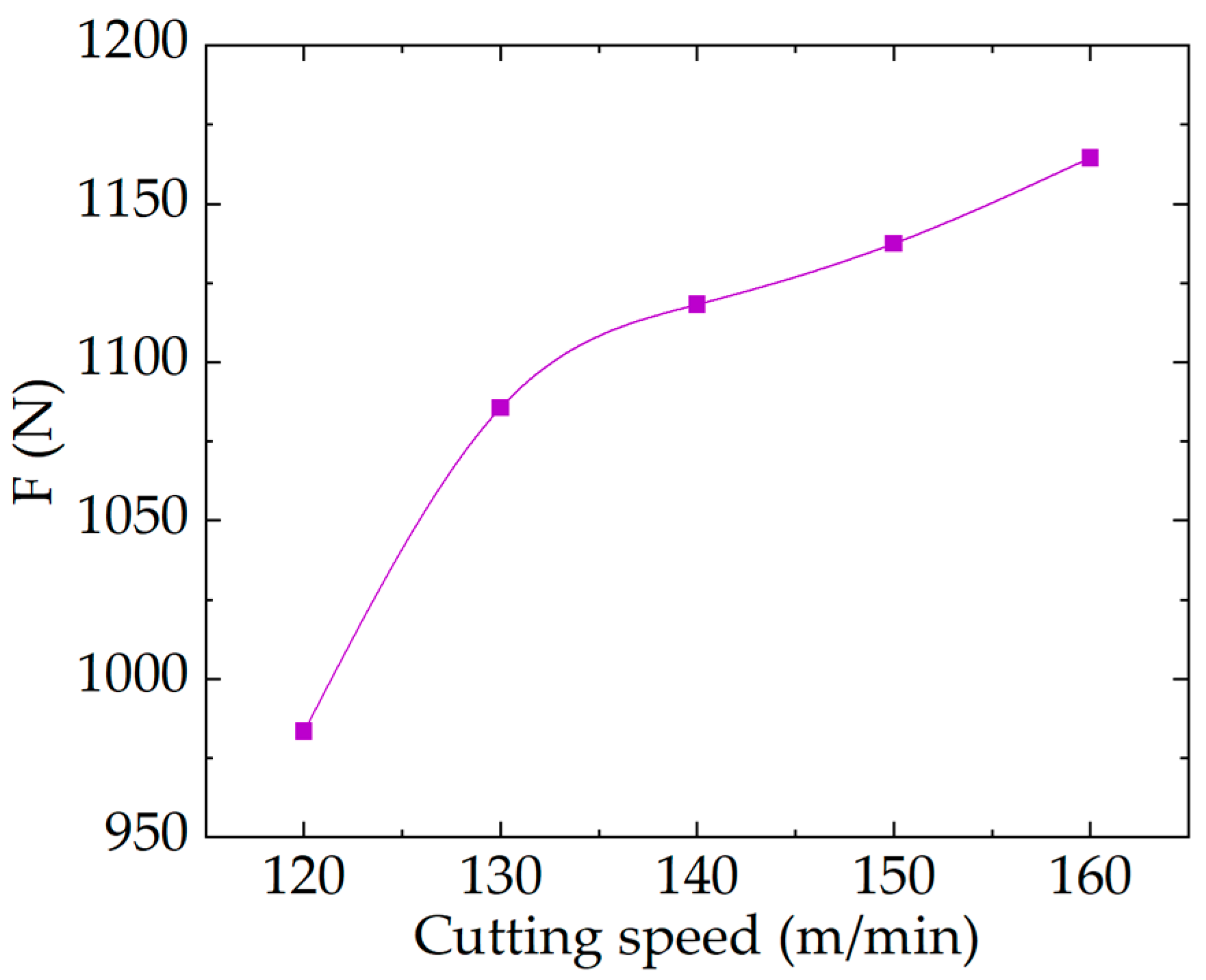Finite Element Modeling and Optimization Analysis of Cutting Force in Powder Metallurgy Green Compacts
Abstract
:Highlights
- Effect magnitude on cutting force, in descending order: cutting thickness, rounded edge radius, cutting speed, tool rake angle.
- Optimal process parameters identified for minimizing cutting force: cutting thickness of 0.20 mm, cutting speed of 120 m/min, tool rake angle of 0°, rounded edge radius of 40 μm—resulting in a cutting force of 887.95 N.
- Addresses the understudied area of cutting forces in powder metallurgy green compacts.
Abstract
1. Introduction
2. Simulation Model Building and Experimental Verification
2.1. Pore Characterization and Modeling
2.2. Workpiece Model Parameters
2.3. Tool-Related Parameters
2.4. Workpiece Meshing and Overall Model Assembly
2.5. Experimental Validation
3. Finite Element Simulation Results and Discussion
3.1. Univariate Analysis
3.2. Multivariate Analysis
4. Conclusions
- (1)
- Cutting force exhibited a 31.65% increase when the cutting thickness ranged from 0.15 mm to 0.35 mm. Similarly, cutting speed variations between 120 m/min and 160 m/min led to a significant 17.62% rise in cutting force. The influence of tool rake angle and rounded-edge radius was comparatively minimal, with respective reductions in cutting force of 3.38% and 2.29%, respectively.
- (2)
- Optimal parameters for minimizing cutting force were identified as a cutting thickness of 0.20 mm, a cutting speed of 120 m/min, a tool rake angle of 0°, and a rounded-edge radius of 40 mm. Utilizing these parameters reduced the cutting force to 887.95 N, achieving significant optimization.
- (3)
- ANOVA results further clarified the varying degrees of influence of each parameter on cutting force. Cutting thickness exhibited the most significant impact, followed by rounded-edge radius and cutting speed, while the tool rake angle had a negligible effect. These insights are pivotal for optimizing the machining process of PM green compacts.
Author Contributions
Funding
Data Availability Statement
Acknowledgments
Conflicts of Interest
References
- Fang, J.X.; Wang, J.X.; Wang, Y.J.; He, H.T.; Zhang, D.B.; Cao, Y. Microstructure evolution and deformation behavior during stretching of a compositionally inhomogeneous TWIP-TRIP cantor-like alloy by laser powder deposition. Mater. Sci. Eng. A 2022, 847, 143319. [Google Scholar] [CrossRef]
- Youness, R.A.; Saleh, H.A.; Taha, M.A. Microstructure and Elastic Properties of Hydroxyapatite/Alumina Nanocomposites Prepared by Mechanical Alloying Technique for Biomedical Applications. Biointerface Res. Appl. Chem. 2023, 13, 395. [Google Scholar]
- Youness, R.A.; Amer, M.S.; Taha, M.A. Tribo-mechanical measurements and in vivo performance of zirconia-containing biphasic calcium phosphate material implanted in a rat model for bone replacement applications. Mater. Chem. Phys. 2022, 285, 126085. [Google Scholar] [CrossRef]
- Erdem, M.; Cinici, H.; Gokmen, U.; Karakoc, H.; Turker, M. Mechanical and ballistic properties of powder metal 7039 aluminium alloy joined by friction stir welding. Trans. Nonferrous Met. Soc. China 2016, 26, 74–84. [Google Scholar] [CrossRef]
- Tijo, D.; Kumari, S.; Masanta, M. Hard and wear resistance TiC-composite coating on AISI 1020 steel using powder metallurgy tool by electro-discharge coating process. J. Braz. Soc. Mech. Sci. Eng. 2017, 39, 4719–4734. [Google Scholar] [CrossRef]
- Zharov, M.V. Comparative Analysis of Features of Technologies for Obtaining Quality Spherical Powder of Nickel Aluminide NiAl. Metallurgist 2023, 66, 1401–1411. [Google Scholar] [CrossRef]
- Sadeghi, B.; Cavaliere, P. Progress of Flake Powder Metallurgy Research. Metals 2021, 11, 931. [Google Scholar] [CrossRef]
- Boujelbene, M.; Ezeddini, S.; Ben Said, L.; Bayraktar, E.; Alhadri, M.; Aich, W.; Ghachem, K.; Kolsi, L. Analysis of surface integrity of intermetallic composite based on titanium-aluminum machined by laser cutting. Opt. Laser Technol. 2023, 161, 109187. [Google Scholar] [CrossRef]
- Egorov, M.S.; Egorova, R.V. Characteristics of the Formation of Structure and Properties of Dispersed-Hardened Charges at the Hot Stamping of Complex Shape Products. Metallurgist 2023, 66, 1436–1441. [Google Scholar] [CrossRef]
- Wolfe, T.A.; Shah, R.M.; Prough, K.C.; Trasorras, J.L. Binder jetting 3D printed cemented carbide: Mechanical and wear properties of medium and coarse grades. Int. J. Refract. Met. Hard Mater. 2023, 113, 106197. [Google Scholar] [CrossRef]
- Gobivel, K.; Sekar, K.S.V. Machinability Studies on the Turning of Magnesium Metal Matrix Composites. Arch. Metall. Mater. 2022, 67, 939–948. [Google Scholar]
- Sun, F.J.; Qu, S.G.; Li, G.; Pan, Y.X.; Li, X.Q. Comparison of the machinability of titanium alloy forging and powder metallurgy materials. Int. J. Adv. Des. Manuf. Technol. 2016, 85, 1529–1538. [Google Scholar] [CrossRef]
- da Silva, G.C.; Saraiva, Q.M.; Carneiro, J.R.G.; Santos, I.A.; José, A.S. New milling methodology for sealing planes in AlSi9Cu3(Fe) alloy machined with PCD tool. Int. J. Adv. Manuf. Technol. 2021, 113, 3211–3223. [Google Scholar] [CrossRef]
- Zhong, B.; Wang, Y.R.; Wei, D.S.; Zhang, K.S.; Wang, J.L. Multiaxial fatigue life prediction for powder metallurgy superalloy FGH96 based on stress gradient effect. Int. J. Fatigue 2018, 109, 26–36. [Google Scholar] [CrossRef]
- Attia, U.M. Cold-isostatic pressing of metal powders: A review of the technology and recent developments. Crit. Rev. Solid State Mater. Sci. 2021, 46, 587–610. [Google Scholar] [CrossRef]
- Dong, X.J.; Wu, J.Q.; Yu, H.L.; Zhou, Q.; Wang, W.Q.; Zhang, X.Q.; Zhang, L.; Li, L.; He, R.J. Additive manufacturing of silicon nitride ceramics: A review of advances and perspectives. Int. J. Appl. Ceram. Technol. 2022, 19, 2929–2949. [Google Scholar] [CrossRef]
- Yin, Y.K.; Xu, J.Y.; Ji, M.; Li, L.F.; Chen, M. A critical review on sintering and mechanical processing of 3Y-TZP ceramics. Ceram. Int. 2023, 49, 1549–1571. [Google Scholar] [CrossRef]
- Kulkarni, H.; Dabhade, V. Green machining of powder-metallurgy-steels (PMS): An overview. J. Manuf. Process. 2019, 44, 1–18. [Google Scholar] [CrossRef]
- Chen, C.; Huang, B.Y.; Liu, Z.M.; Li, Y.X.; Zou, D.; Liu, T.; Chang, Y.M.; Chen, L. Additive manufacturing of WC-Co cemented carbides: Process, microstructure, and mechanical properties. Addit. Manuf. 2023, 63, 103410. [Google Scholar] [CrossRef]
- Parvizi, S.; Hashemi, S.M.; Asgarinia, F.; Nematollahi, M.; Elahinia, M. Effective parameters on the final properties of NiTi-based alloys manufactured by powder metallurgy methods: A review. Prog. Mater. Sci. 2021, 117, 100739. [Google Scholar] [CrossRef]
- Bram, M.; Ebel, T.; Wolff, M.; Cysne Barbosa, A.P.; Tuncer, N. Applications of Powder Metallurgy in Biomaterials. Adv. Powder. Metall. Part Mater. 2013, 520–554. [Google Scholar] [CrossRef]
- Paradis, L.; Waryoba, D.; Robertson, K.; Ndayishimiye, A.; Fan, Z.M.; Rajagopalan, R.; Randall, C.A. Densification and Strengthening of Ferrous-Based Powder Compacts Through Cold Sintering Aided Warm Compaction. Adv. Eng. Mater. 2022, 24, 2200714. [Google Scholar] [CrossRef]
- Moustafa, E.B.; Ghandourah, E.; Youness, R.A.; Melaibari, A.A.; Taha, M.A. Ultralight Functionally Graded Hybrid Nanocomposites Based on Yttrium and Silica-Reinforced Mg10Li5Al Alloy: Thermal and Tribomechanical Properties. Materials 2023, 15, 9052. [Google Scholar] [CrossRef]
- Issa, S.A.M.; Almutairi, A.M.; Albalawi, K.; Dakhilallah, O.K.; Zakaly, H.M.H.; Ene, A.; Abulyazied, D.E.; Ahmed, S.M.; Youness, R.A.; Taha, M.A. Production of Hybrid Nanocomposites Based on Iron Waste Reinforced with Niobium Carbide/Granite Nanoparticles with Outstanding Strength and Wear Resistance for Use in Industrial Applications. Nanomaterials 2023, 13, 537. [Google Scholar] [CrossRef] [PubMed]
- Alazwari, M.A.; Moustafa, E.B.; Khoshaim, A.B.; Taha, M.A. Mechanical and wear evolution of in situ synthesized Ti–Cu alloy matrix hybrid composite reinforced by low-cost activated carbon and silica fume waste ceramic for industrial applications. J. Mater. Res. Technol. 2023, 22, 2284–2296. [Google Scholar] [CrossRef]
- Ramadan, S.; Taha, M.A.; El-Meligy, W.M.; Saudi, H.A.; Zawrah, M.F. Influence of Graphene Content on Sinterability and Physico-Mechanical Characteristics of Al/Graphene Composites Prepared via Powder Metallurgy. Biointerface Res. Appl. Chem. 2023, 13, 192. [Google Scholar]
- Robert-Perron, E.; Blais, C.; Pelletier, S. Tensile properties of sinter hardened powder metallurgy components machined in their green state. Powder Metall. 2009, 52, 80–83. [Google Scholar] [CrossRef]
- Yang, D.Y.; Lu, L.S.; Wan, Z.P. Material Removal Mechanism of Green Machining on Powder Metallurgy Parts during Orthogonal Cutting. Adv. Mater. Sci. Eng. 2020, 2020, 1962602. [Google Scholar] [CrossRef]
- Kulkarni, H.; Dabhade, V.V.; Blais, C. Analysis of machining green compacts of a sinter-hardenable powder metallurgy steel: A perspective of material removal mechanism. CIRP J. Manuf. Sci. Technol. 2023, 41, 430–445. [Google Scholar] [CrossRef]
- Goncalves, M.; Sanchez, L.E.D.; Franca, T.V.; Fortulan, C.A.; da Silva, R.H.L.; Foschini, C.R. Analysis of the tool nose radius influence in the machining of a green ceramic material. Int. J. Adv. Manuf. Technol. 2019, 105, 3117–3125. [Google Scholar] [CrossRef]
- Kumar, P.; Karsh, P.K.; Misra, J.P.; Kumar, J. Multi-objective optimization of machining parameters during green machining of aerospace grade titanium alloy using Grey-Taguchi approach. Proc. Inst. Mech. Eng. Part E 2021, 09544089211043610. [Google Scholar] [CrossRef]
- Bidulska, J.; Bidulsky, R.; Grande, M.A.; Kvackaj, T. Different Formation Routes of Pore Structure in Aluminum Powder Metallurgy Alloy. Materials 2019, 12, 3724. [Google Scholar] [CrossRef] [PubMed]
- Shokry, A.; Gowid, S.; Mulki, H.; Kharmanda, G. On the Prediction of the Flow Behavior of Metals and Alloys at a Wide Range of Temperatures and Strain Rates Using Johnson-Cook and Modified Johnson-Cook-Based Models: A Review. Materials 2023, 16, 1574. [Google Scholar] [CrossRef] [PubMed]
- Wang, L.; Wang, C.; Du, W.; Xie, G.; Song, K.; Wang, X.; Zhao, F. Parameter optimization of a four-legged robot to improve motion trajectory accuracy using signal-to-noise ratio theory. Robot. Comput. Manuf. 2018, 51, 85–96. [Google Scholar] [CrossRef]
- Arumbu, P.; Srinivasalu, S. Sustainable model for high signal to noise ratio to measure underwater acoustic signal using Acoustic Doppler Velocimeter. Comput. Electr. Eng. 2018, 68, 262–270. [Google Scholar] [CrossRef]
- Wojciechowski, S.; Maruda, R.W.; Krolczyk, G.M.; Niesłony, P. Application of signal to noise ratio and grey relational analysis to minimize forces and vibrations during precise ball end milling. Precis. Eng. 2018, 51, 582–596. [Google Scholar] [CrossRef]
- Hüseyin, G.; Yunus, E.G. Optimization and evaluation of dry and minimum quantity lubricating methods on machinability of AISI 4140 using Taguchi design and ANOVA. Proc. Inst. Mech. Eng. Part C J. Mech. Eng. Sci. 2020, 235, 1211–1227. [Google Scholar]
- Imrek, B.; Oral, A. Experimental investigation of flank wear in variable feed turning of cold work tool steel DIN 1.2379, optimization of variable feed levels. J. Fac. Eng. Archit. Gazi Univ. 2022, 38, 409–419. [Google Scholar]
- Thankachan, T.; Prakash, K.S.; Malini, R.; Ramu, S.; Sundararaj, P.; Rajandran, S.; Ramasamy, D.; Jothi, S. Prediction of surface roughness and material removal rate in wire electrical discharge machining on aluminum based alloys/composites using Taguchi coupled Grey Relational Analysis and Artificial Neural Networks. Appl. Surf. Sci. 2019, 472, 22–35. [Google Scholar] [CrossRef]
- Naik, A.B.; Reddy, A.C. Optimization of Tensile Strength in TIG Welding Using Taguchi Method and Analysis of Variance (ANOVA). Therm. Sci. Eng. Prog. 2018, 8, 327–339. [Google Scholar] [CrossRef]
- Savković, B.; Kovăc, P.; Stoić, A.; Dudić, B. Optimization of Machining Parameters Using the Taguchi and ANOVA Analysis in the Face Milling of Aluminum Alloys AL7075. Teh. Vjesn. 2020, 27, 1221–1228. [Google Scholar]
- Deng, C.S.; Hsia, K.L. Analysis of the optimisation of parameters for the laser machining of timber. Int. J. Adv. Manuf. Technol. 2017, 89, 3721–3729. [Google Scholar] [CrossRef]
- Kruzel, R.; Dembiczak, T.; Wachowicz, J. Optimization of Spark Plasma Sintering Technology by Taguchi Method in the Production of a Wide Range of Materials: Review. Materials 2023, 16, 5539. [Google Scholar] [CrossRef] [PubMed]










| Performance | Density (g/cm3) | Vickers Hardness (HV) | Tensile Strength (MPa) | Compressive Strength (MPa) | Elastic Modulus (GPa) | Poisson’s Ratio |
|---|---|---|---|---|---|---|
| Parameter | 7.1 | 87 | 3.9 | 98 | 210 | 0.018 |
| Parameter | A (MPa) | B (MPa) | C | m | n | Tm (°C) | Tr (°C) |
|---|---|---|---|---|---|---|---|
| Value | 730 | 487 | 0.016 | 1.08 | 0.29 | 1861 | 25 |
| Material | Density (g/cm3) | Elastic Modulus (MPa) | Poisson’s Ratio | Coefficient of Expansion α/(×10−6/°C) | Specific Heat Capacity (J/kg·°C) | Thermal Conductivity (N/sec/°C) |
|---|---|---|---|---|---|---|
| WC | 14.7 | 630 | 0.24 | 4.4 | 1.5 | 59 |
| Serial Number | Cutting Thickness ap (mm) | Cutting Speed vc (m/min) | Tool Rake Angle γo | Rounded Edge Radius rε (μm) |
|---|---|---|---|---|
| 1 | 0.15 | 120 | 0° | 10 |
| 2 | 0.20 | 130 | 5° | 20 |
| 3 | 0.25 | 140 | 10° | 30 |
| 4 | 0.30 | 150 | 15° | 40 |
| Test Number (i) | Column Number (g) | Cutting Force Simulation Results (N) | |||
|---|---|---|---|---|---|
| A | B | C | D | ||
| 1 | 1 | 1 | 1 | 1 | 932.99 |
| 2 | 1 | 2 | 2 | 2 | 1071.53 |
| 3 | 1 | 3 | 3 | 3 | 1047.71 |
| 4 | 1 | 4 | 4 | 4 | 1027.78 |
| 5 | 2 | 1 | 2 | 3 | 891.57 |
| 6 | 2 | 2 | 1 | 4 | 917.65 |
| 7 | 2 | 3 | 4 | 1 | 1075.34 |
| 8 | 2 | 4 | 3 | 2 | 1148.25 |
| 9 | 3 | 1 | 3 | 4 | 958.27 |
| 10 | 3 | 2 | 4 | 3 | 1074.77 |
| 11 | 3 | 3 | 1 | 2 | 1216.67 |
| 12 | 3 | 4 | 2 | 1 | 1230.24 |
| 13 | 4 | 1 | 4 | 2 | 1334.90 |
| 14 | 4 | 2 | 3 | 1 | 1418.63 |
| 15 | 4 | 3 | 2 | 4 | 1133.26 |
| 16 | 4 | 4 | 1 | 3 | 1377.53 |
| Machining Parameters | Parameter Value | Signal-to-Noise Ratio |
|---|---|---|
| ap (mm) | 0.15 | −60.1601 |
| 0.20 | −60.0221 | |
| 0.25 | −60.9398 | |
| 0.30 | −62.3537 | |
| vc (m/min) | 120 | −60.1348 |
| 130 | −60.8793 | |
| 140 | −60.9564 | |
| 150 | −61.5051 | |
| γo (°) | 0 | −60.7841 |
| 5 | −60.6224 | |
| 10 | −61.0682 | |
| 15 | −61.0011 | |
| rε (μm) | 10 | −61.2164 |
| 20 | −61.5033 | |
| 30 | −60.7041 | |
| 40 | −60.0520 |
| Test Number (i) | Column Number (g) | FH (yi) | ||||
|---|---|---|---|---|---|---|
| A | B | C | D | |||
| 1 | 1 | 1 | 1 | 1 | 932.99 | |
| 2 | 1 | 2 | 2 | 2 | 1071.53 | |
| 3 | 1 | 3 | 3 | 3 | 1047.71 | |
| 4 | 1 | 4 | 4 | 4 | 1027.78 | |
| 5 | 2 | 1 | 2 | 3 | 891.57 | |
| 6 | 2 | 2 | 1 | 4 | 917.65 | |
| 7 | 2 | 3 | 4 | 1 | 1075.34 | |
| 8 | 2 | 4 | 3 | 2 | 1148.25 | |
| 9 | 3 | 1 | 3 | 4 | 958.27 | |
| 10 | 3 | 2 | 4 | 3 | 1074.77 | |
| 11 | 3 | 3 | 1 | 2 | 1216.67 | |
| 12 | 3 | 4 | 2 | 1 | 1230.24 | |
| 13 | 4 | 1 | 4 | 2 | 1334.90 | |
| 14 | 4 | 2 | 3 | 1 | 1418.63 | |
| 15 | 4 | 3 | 2 | 4 | 1133.26 | |
| 16 | 4 | 4 | 1 | 3 | 1377.53 | |
| 4080.01 | 4117.73 | 4444.84 | 4657.20 | 17,857.09 (y·) 19,929,728.95 (CT) | ||
| 4032.81 | 4482.58 | 4326.60 | 4771.35 | |||
| 4479.95 | 4472.98 | 4572.86 | 4391.58 | |||
| 5264.32 | 4783.80 | 4512.79 | 4036.96 | |||
| 16,646,481.60 | 16,955,700.35 | 19,756,602.63 | 21,689,511.84 | |||
| 16,263,556.50 | 20,093,523.46 | 18,719,467.56 | 22,765,780.82 | |||
| 20,069,952.00 | 20,007,550.08 | 20,911,048.58 | 19,285,974.90 | |||
| 27,713,065.06 | 22,884,742.44 | 20,365,273.58 | 16,297,046.04 | |||
| 243,534.836 | 55,650.12817 | 8369.133069 | 79,849.44587 | |||
| Variation Source | Square of Deviance | Degree of Freedom | Sum of Mean Squares | F | Significance | F0.05 | F0.01 |
|---|---|---|---|---|---|---|---|
| ap (mm) | 243,534.836 | 3 | 81,178.27867 | 29.8459722 | ** | 6.59 | 16.69 |
| vc (m/min) | 55,650.12817 | 3 | 18,550.04272 | 6.820100999 | * | ||
| γo (°) | 8369.133069 | 3 | 2789.711023 | 1.025663995 | ns | ||
| rε (μm) | 79,849.44587 | 3 | 26,616.48196 | 9.785804695 | * | ||
| Error | 10,879.62933 | 4 | 2719.907334 | / | / | ||
| Summation | 398,283.1724 | 16 | / | / | / |
Disclaimer/Publisher’s Note: The statements, opinions and data contained in all publications are solely those of the individual author(s) and contributor(s) and not of MDPI and/or the editor(s). MDPI and/or the editor(s) disclaim responsibility for any injury to people or property resulting from any ideas, methods, instructions or products referred to in the content. |
© 2023 by the authors. Licensee MDPI, Basel, Switzerland. This article is an open access article distributed under the terms and conditions of the Creative Commons Attribution (CC BY) license (https://creativecommons.org/licenses/by/4.0/).
Share and Cite
Yang, D.; Zhang, Y.; Wang, R.; Wei, F.; Zeng, L.; Liu, M. Finite Element Modeling and Optimization Analysis of Cutting Force in Powder Metallurgy Green Compacts. Processes 2023, 11, 3186. https://doi.org/10.3390/pr11113186
Yang D, Zhang Y, Wang R, Wei F, Zeng L, Liu M. Finite Element Modeling and Optimization Analysis of Cutting Force in Powder Metallurgy Green Compacts. Processes. 2023; 11(11):3186. https://doi.org/10.3390/pr11113186
Chicago/Turabian StyleYang, Dayong, Yuchen Zhang, Rui Wang, Furui Wei, Lingxin Zeng, and Min Liu. 2023. "Finite Element Modeling and Optimization Analysis of Cutting Force in Powder Metallurgy Green Compacts" Processes 11, no. 11: 3186. https://doi.org/10.3390/pr11113186
APA StyleYang, D., Zhang, Y., Wang, R., Wei, F., Zeng, L., & Liu, M. (2023). Finite Element Modeling and Optimization Analysis of Cutting Force in Powder Metallurgy Green Compacts. Processes, 11(11), 3186. https://doi.org/10.3390/pr11113186






